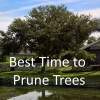
Finding the Balance
A tree is more interesting and visually pleasing without the overgrown look caused by an abundance of small limbs. However, the removal of small limbs is not in the best interest of the tree.
More Leaves More Photosynthesis
A tree is a living organism that produces its food (photosynthesis). The small limbs provide food locally to where it is attached. Removing the small limbs reduces food overall and to the limb, it is attached.
Wind Mitigation
Wind applies pressure (energy) to the tree. Branches with foliage on the ends apply all the pressure to the branch ends acting like a lever ripping the limb from the trunk. A limb with foliage along the branch distributes the pressure (energy) along the entire branch and is more likely to survive high winds. This same concept can be applied to the overall canopy – a full canopy distributes the wind loads over the entire tree not just isolated limbs.
Center Pruning vs. Selective Pruning
Center pruning removes all small branches in the interior of the tree. Selective pruning is more nuanced, selecting small limbs to remove for visual appeal and the survival of the tree. Center pruning removes food, selective pruning maintains food production. In high winds, center pruning will cause limb failure, selective pruning distributes wind loads reducing failure.
Arborist Knows Best
Selective pruning is an art and science – there are no hard-defined rules. However, a trained experienced arborist will determine what is best for the tree and visually pleasing.



